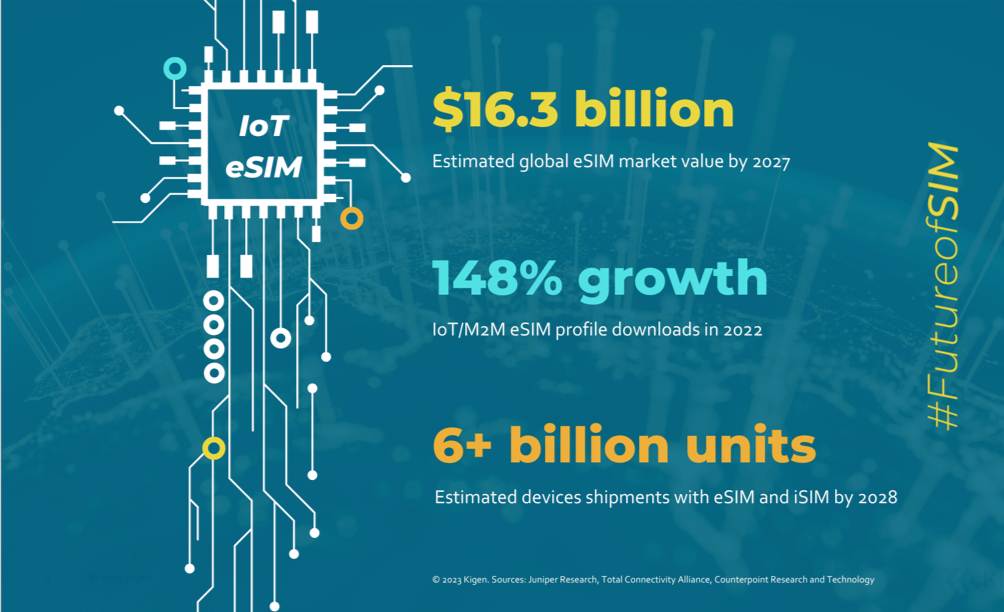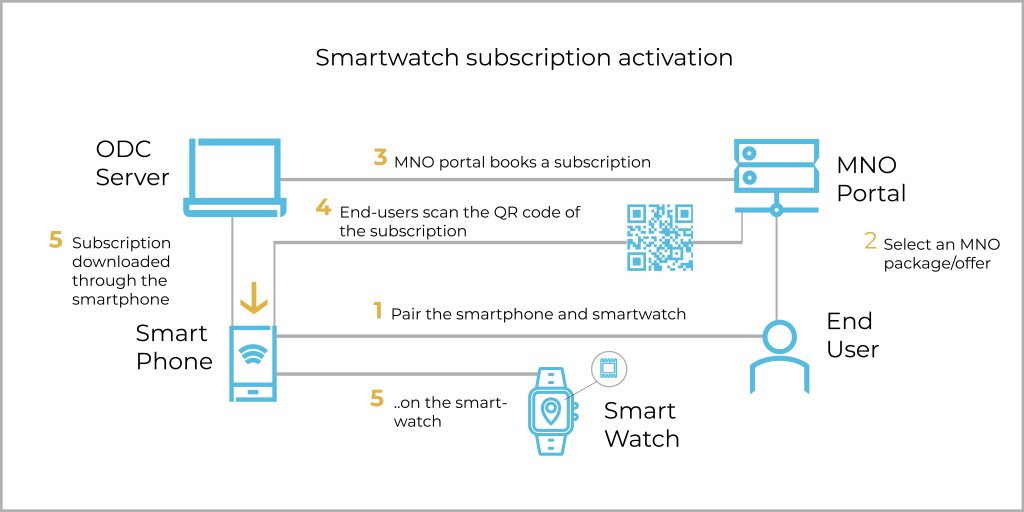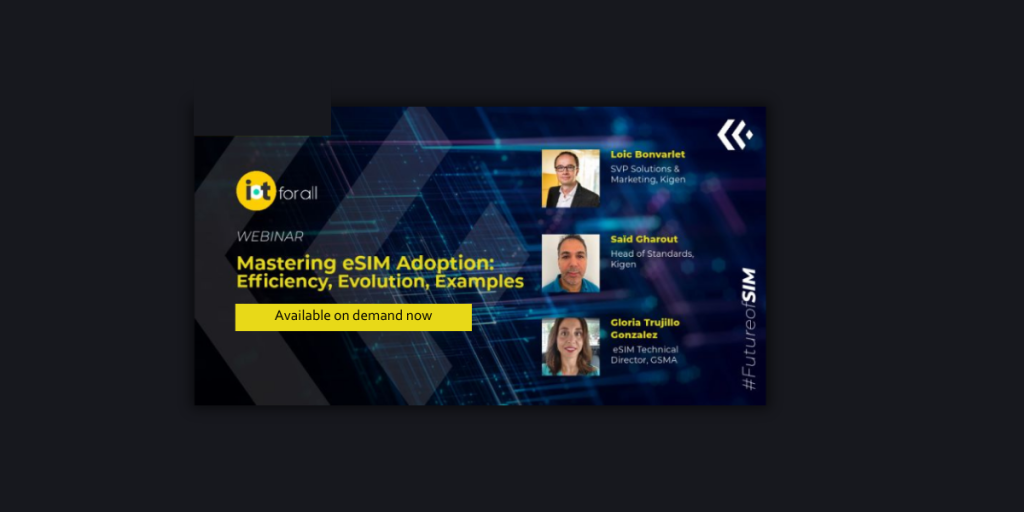
- Resources
- Blog
The growth of eSIM-compatible smartwatches in India
Introduction
In the dynamic landscape of smartwatches, eSIM technology has emerged as a significant game changer for streaming and cellular coverage functionality. This blog post explores the rapid adoption of eSIM technology due to its consumer-friendly subscription delivery, integration into trusted payment, health, and other services essential to digital life, plus the reduction in plastic usage.
Additionally, eSIM complements the fast-paced digital move to 5G from leading telecom operators to benefit from a deeper, faster, and more reliable experience for end users. Let’s look at the opportunities for Original Equipment Manufacturers (OEMs) as they align themselves with this transformative technology in burgeoning markets such as India.
The Acronyms Decoded
Before we jump in, let’s decode some of the acronyms in this post for better clarity:
eSIM: Embedded Subscriber Identity Module OEMs: Original Equipment Manufacturers
OEMs: Original Equipment Manufacturers
QR Code: Quick Response Code with the address of the Remote SIM Provisioning system SM-DP+ server, allowing the device to connect and download a SIM profile securely
MFF2: M2M Form Factor 2
eSIM WhitePaper from GSMA: https://www.gsma.com/esim/wp-content/uploads/2018/12/esim-whitepaper.pdf
Frequently asked questions
We frequently get asked questions (thank you, please keep these coming on our LinkedIn and X social networks!) on eSIMs in smartwatches from OEM, telco, and consumer perspectives. So, here are the top 5 most asked questions.
1. What is e-SIM?
Read the quick primer on eSIM and its associated remote provisioning functionality and choices in our earlier blog – an ideal resource for anyone when time matters! Also worth referencing the GSMA
2. Where is eSIM available in India?
In recent weeks, several major telecom service providers have launched eSIM smart including Reliance Jio for the boat smartwatch, and Vodafone Idea launched eSIM services.
3. Some eSIM-enabled smartwatches
eSIM technology first became famous through leading smartwatches, such as the Samsung Gear S2 Classic 3G, launched in 2016, and the Apple Watch Series 3, launched in 2017. Since then, Fitbit (Ionic, established in 2017), Huawei (Watch 2 – 4G Variant, launched 2017), Garmin (Vivoactive 3 Music, launched 2018), and others have become increasingly popular.
eSIMs have gained everyday resonance as a technology through their increasing integration into smartphones: In India, Apple consumers can use eSIMs on their eSIM-enabled Reliance Jio and Airtel connectivity data plans. Android device ecosystem, which represents around 85 percent of smartphones in use, has also recently been enabled with eSIM by leading network operators, and more are joining the shift to eSIM usage.
4. How do you activate an eSIM on a smartwatch?
As with physical SIM cards, no manual insertion or SIM removal pins are needed to activate an eSIM. One of the standout features of eSIM technology is its user-friendly activation process. Consumers can subscribe to network services through a QR code with some providers for easy onboarding.
Some major network operators such as Reliance Jio and Airtel have quickly adopted this convenient approach, streamlining the activation of eSIMs for a hassle-free user experience. This allows consumers faster activation than physical SIM cards, reducing wait time.
5. What is needed for eSIM functionality?
As defined by GSMA eSIM Standards, which Kigen has been collaborating to develop, there are four main components of a GSMA-compliant eSIM architecture:
· The eUICC is the software that allows provisioning
· The Local Profile Assistant (LPA) provides a list of installed profiles and when combined with the SMDP+, acts as a local proxy
· The eSIM profile stores the user’s subscription and network settings and allows the user to connect to the corresponding mobile network
· The Subscription Manager Data Preparation platform (aka SM-DP+, i.e., the eSIM subscription management server downloads the eSIM profile stored securely on the eUICC. This is done via a GSMA-certified SAS-UP and SAS-SM data center. Once the operator’s BSS creates the subscription, it informs the SM-DP+ about its availability and requires completing an eSIM profile.



eSIM global market growth
The Rise of eSIM Technology in Smart Wearables
As smartwatches become integral to our daily lives, the need for reliable and efficient connectivity has skyrocketed. Traditional SIM cards, with their physical limitations, have paved the way for a growing demand for eSIM technology. eSIM embedded within the device eliminates the need for a physical card, enabling manufacturers to design sleeker, more compact devices.
eSIM technology digitalizes connectivity distribution, and by far, its biggest draw is the improved customer experience by allowing the user to connect to the desired mobile network subscription while on the move.
Smartwatches with streaming and cellular coverage functionality demand a robust and flexible connectivity solution, making eSIM a natural fit. The ease of embedding eSIMs into these devices opens a realm of possibilities, allowing users to make calls, stream content, and stay connected on the go without the hassle of physical SIM cards.
India’s Digital Economy: A Catalyst for eSIM Adoption
Before delving into the specifics of eSIM adoption in smart wearables, it’s crucial to understand the backdrop of India’s digital economy. The subcontinent is experiencing an unprecedented digital revolution, with a rapidly growing number of smartphone users and an increasing reliance on digital services.
Already the third largest digital economy, India is expected to record the fastest digital growth at 9.6% from 2023 to 27, according to the Omdia-FT Digital Economies tracker. India’s digital economy is poised to reach new heights, presenting a fertile ground for integrating advanced technologies like eSIM.
Cellular smartwatches are more popular than Bluetooth among Indian professionals
Indian professionals prefer eSIM watches over Bluetooth because they always have their phones. This is especially true for Indian youth who enjoy trekking, riding, and running. It is more convenient for them to carry a watch than a phone. They can leave their phone at home and stay in touch with their friends while conducting their hobbies.
For working professionals, it can help improve work efficiency by enabling quick responses to messages, emails, and notifications without pulling out a phone.
It allows fitness enthusiasts to monitor their health metrics, track workouts, and stay connected even during exercise without needing a phone. A cellular smartwatch also helps to make emergency calls directly from the wrist, especially when their phone is not easily accessible.
But, In India, pricing is also a significant consideration. Therefore, market penetration is also determined by the additional cost of services acceptable to end consumers. To this point, Apple phones are gaining popularity in India, with many young people and professionals opting for them.
OEMs Embrace eSIM Technology for Wider Device Integration
Original Equipment Manufacturers (OEMs) are at the forefront of building eSIM technology into various devices, moving beyond traditional smartphones. Smart wearables, including fitness trackers and smartwatches, have become the epicenter of this transformation. Market leaders are recognizing the need to provide users with seamless connectivity across their device ecosystem, and eSIM technology is the linchpin that makes this possible.
OEMs should look to gain an advantage by choosing an energy-efficient eSIM OS optimized for a low-power, small footprint and available on a broad range of leading chipsets, which is essential when operating in a price-sensitive market. Furthermore, support for multiple activation journeys may also be a factor for consumers in choosing a given model in concert with the operator-operate subscription or where the smartwatch is purchased separately.
Unlocking Connectivity with QR Codes: A User-Friendly Approach
As mentioned earlier, eSIMs are growing in popularity to address a more comprehensive set of devices and improve the customer experience of network activation. There are multiple ways in which eSIM-enabled smartwatches can connect to the user’s desired network subscription.
- Activation with QR code
- Default SM-DP+ activation
- Out-of-the-box connectivity with preloaded eSIMs using Indian operator profiles



Reducing Plastic Waste with eSIM’s MFF2 Form Factor
Apart from its technological prowess, eSIM technology also champions environmental sustainability. The MFF2 (M2M Form Factor 2) form factor of eSIMs allows manufacturers to reduce plastic usage significantly. Unlike traditional SIM cards that require plastic housing, the smaller and more efficient MFF2 eSIMs contribute to reducing electronic waste, aligning with the global call for eco-friendly practices.
Newsletter Sign-up// – Light Gray Inline
Sign-up for our newsletter to receive the latest from Kigen.
OEMs and Network Operators: A Joint Responsibility
As the adoption of eSIM technology grows, OEMs and network operators bear a shared responsibility to minimize their environmental footprint. Collaborative efforts are needed to implement sustainable practices throughout the production and usage lifecycle. From eco-friendly packaging to responsible disposal mechanisms, the industry must take concerted steps to contribute positively to the environment.
Choosing an Energy-Efficient eSIM Security OS for Maximized Battery Life
Beyond the convenience and environmental benefits, the choice of an energy-efficient eSIM security Operating System (OS) plays a pivotal role in the overall performance of smart wearables. The market offers various options, but conscientious OEMs opt for the most energy-efficient eSIM security OS to maximize battery life. An efficient OS ensures that the device remains operational for extended periods, enhancing the user experience and reducing the need for frequent recharging.
Conclusion
In conclusion, the adoption of eSIM technology in smart wearables, particularly in smartwatches with streaming and cellular coverage functionality, is reshaping the connectivity landscape. As India’s digital economy continues to thrive, OEMs are strategically aligning themselves with this transformative technology to meet the growing demands of consumers.
The eSIM’s user-friendly activation process through QR codes and its contribution to reducing plastic waste underscore its significance in sustainable and streamlined connectivity. OEMs and network operators must work hand in hand to foster eco-friendly practices, ensuring a positive environmental impact.
By choosing the more energy-efficient eSIM security OS, OEMs not only enhance the performance of their devices but also contribute to a greener future. The eSIM revolution is not just about technological advancements; it’s a holistic approach towards connectivity that respects the environment and empowers users in the digital age.
Meet our eSIM solutions experts
Discuss your needs today with our experts and explore our India eSIM ecosystem.




